前交叉韧带重建中股骨隧道长度的影响因素分析
2017-12-19王迎春于利锋廖炳辉甄志雷张春礼第四军医大学西京医院骨科运动损伤科西安710032通讯作者mailzhangcl816sohucom
王迎春,丁 明,于利锋,廖炳辉,甄志雷,徐 虎,张春礼(第四军医大学西京医院骨科运动损伤科,西安 710032;通讯作者,E-mail:zhangcl816@sohu.com)
前交叉韧带重建中股骨隧道长度的影响因素分析
王迎春,丁 明,于利锋,廖炳辉,甄志雷,徐 虎,张春礼*
(第四军医大学西京医院骨科运动损伤科,西安 710032;*通讯作者,E-mail:zhangcl816@sohu.com)
目的 探讨膝关节前交叉韧带重建术中股骨隧道长度的影响因素。 方法 采用回顾性研究方法,收集100例前交叉韧带断裂的患者,于术后采用X线和双能量CT扫描三维重建的方法,测量评估股骨隧道入口定位、出口位置和股骨髁大小,分析以上因素对股骨隧道长度的影响。 结果 Bernard四格表法X轴定位在不同股骨隧道长度组间差异无统计学意义(P=0.09);Y轴定位在不同股骨隧道长度组间差异有统计学意义(P=0.03)。股骨髁大小在不同股骨隧道长度组间差异有统计学意义(P=0.00)。股骨隧道长度与Bernard四格表法X轴定位为正相关,线性回归方程为y=30.15+25.34x,线性拟合相关系数R2=0.06,P=0.01;与Bernard四格表法Y轴定位为负相关,线性回归方程为y=42.26-16.21x,线性拟合相关系数R2=0.07,P=0.00。股骨隧道长度与股骨髁大小成正相关,线性回归方程为y=13.60+2.54x,线性拟合相关系数R2=0.18,P=0.00。不同隧道出口位置下的股骨隧道长度差异无统计学意义(P=0.48);股骨隧道出口距股骨远端的距离在不同股骨隧道长度组间差异有统计学意义(P=0.00),且成正相关,线性回归方程为y=25.35+2.51x,线性拟合相关系数R2=0.153,P=0.01;术中行髁间窝成形术与未行髁间窝成形术在股骨隧道长度上差异有统计学意义(P=0.04)。 结论 ACL重建术中股骨隧道长度和入口定位、股骨髁大小、股骨隧道出口位置距股骨远端的距离相关,这可在术前进行隧道长度的预评估并作为术中定位的指导。
前交叉韧带; 股骨隧道; 关节镜
前交叉韧带(anterior cruciate ligament,ACL)是维持膝关节稳定性的重要结构[1]。ACL损伤在青少年人群及运动员常见,关节镜下实施ACL重建为主要治疗方法[2]。目前有大量文献研究指出解剖重建ACL能够获得优良的预后,但很少有学者关注ACL重建骨隧道长度的研究[3-5]。
以往ACL重建术中准备股骨隧道采用经胫骨(transtibial,TT)方式,该方式虽然能够获得较长的股骨隧道,有利于腱-骨接触愈合,但隧道入口的“非解剖”却影响术后膝关节的生物力学,导致手术的失败甚至骨关节炎的发生[6,7]。现在采用经前内侧入路(anteromedial portal,AM)方式准备股骨隧道,可轻松地获得股骨隧道的解剖位置,但该方法下股骨隧道太过于倾斜,导致股骨隧道变短,不利于腱-骨接触愈合,甚至可能造成术中股骨外侧髁后壁的爆裂,导致手术失败[7-9]。尽管适于股骨固定的最小隧道长度存在争论,人们一般认为少于25 mm将不会提供足够的接触面积以利于腱-骨接触愈合[10,11]。
我们假设股骨隧道长度和隧道入口定位、出口位置、股骨髁大小具有相关性。因此本研究的目的是通过对比术中测深器测量的股骨隧道长度和术后运用X线及3D-CT评估股骨隧道入口定位、出口位置、股骨髁大小,探讨ACL重建术中股骨隧道长度的影响因素。
1 方法与资料
1.1 病例纳入标准与排除标准
病例纳入标准:①选取2014-08~2016-07期间于我科住院的单侧膝关节ACL断裂患者;②行ACL单束重建术患者;③无多发韧带伤;④双侧膝关节发育正常,无关节畸形;⑤无关节屈伸受限。
病例排除标准:①双侧膝关节ACL损伤患者;②ACL单束(前内或后外侧束)加强重建患者;③关节发育异常或屈伸活动受限;④多发韧带伤患者;⑤孕期妇女或有近期生育计划的患者。
1.2 一般资料
本研究共纳入100例患者,男性75例,女性25例;左侧ACL损伤45例,右侧ACL损伤55例;100例患者均为ACL完全断裂,无内科并发疾病,无合并关节其他韧带损伤。男女患者年龄及受伤至手术时间差异无统计学意义(见表1)。
表1男、女性患者术前一般资料的比较
Table1Comparisonofpreoperativegeneraldatabetweenmaleandfemalepatients

性别年龄(年)病程(月)男性30 09±10 5929 8±15 2女性36 61±13 0435 1±13 7t-3 84-2 59 P0 2830 681
1.3 四格表法评估股骨隧道入口定位,测量出口位置及股骨髁大小
所有纳入病例均于ACL单束重建术后第2天进行膝关节双能量CT(Siemens AG,Germany)扫描,采用Bernard四格表法[12]评估术侧膝关节股骨隧道位置(见图1)。股骨隧道出口的位置评估以Endobutton和股骨干后缘延长线的相对位置进行评估,Endobutton位置位于股骨干后缘延长线之前为A出口点,位于股骨干后缘延长线之后为B出口点(见图2)。使用华海PACS系统在膝关节正位X线片上测量股骨髁大小,为股骨内上髁和外上髁连线的距离;在X线侧位片上测量髓道出口距股骨外髁远端的距离(见图3)。
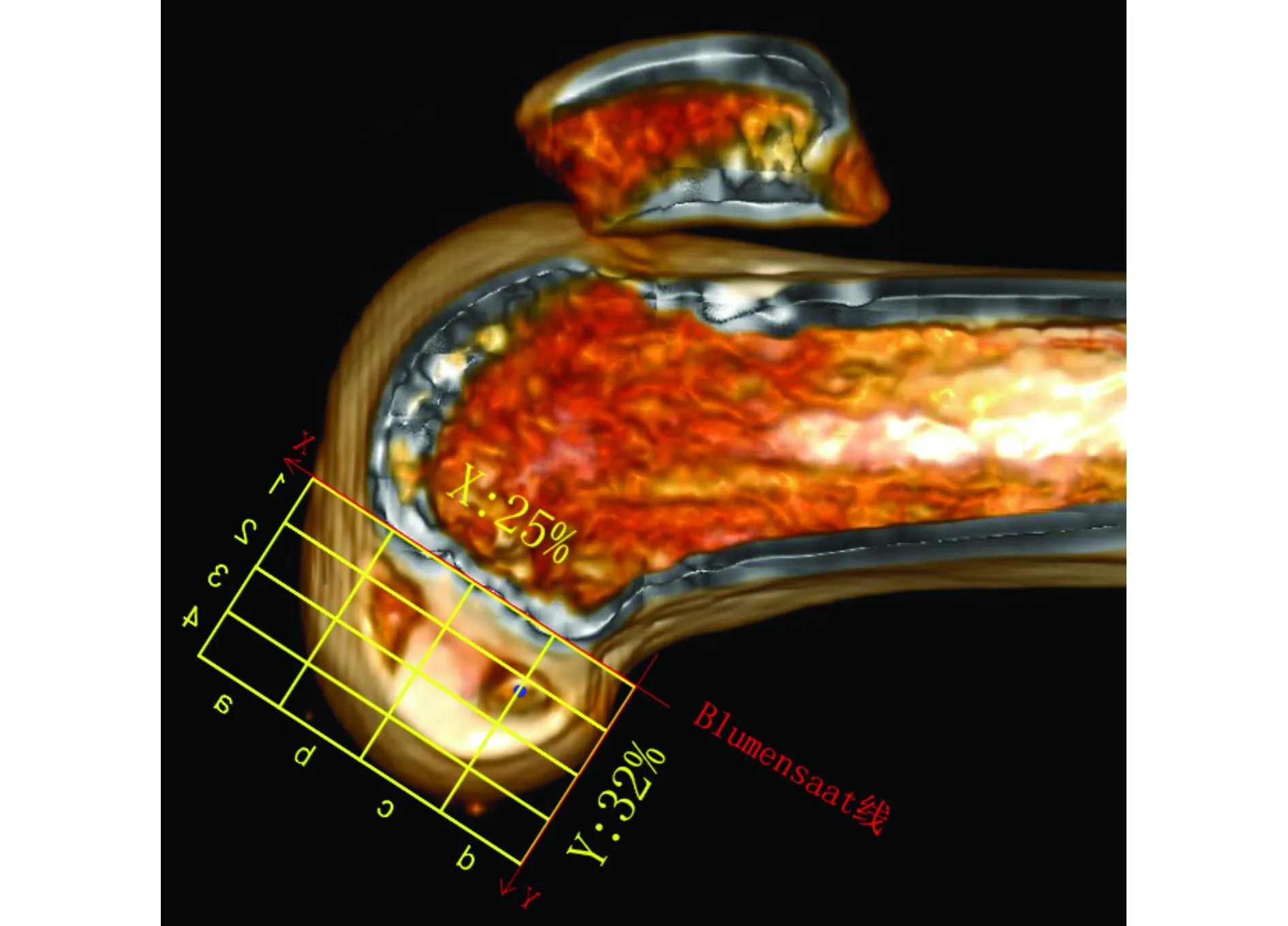
在经髁间窝正中的纵行剖面上,以Blumensaat线为基准边,两端延长线与股骨髁前后轮廓边缘相交点做基准边的垂线,在髁轮廓后下缘做切线平行于基准边,构成矩形,再把矩形内网格化四等分,而矩形的后上角为原点,命名矩形的两个边分别为X、Y轴,矩形内的任何一点均可以用相对于X、Y全长的百分比来定位图1 Bernard四格表法测量评估股骨隧道入口Figure 1 Measurement and evaluation of femoral tunnel entrance by Bernard four lattice table
1.4 统计与分析
采用IBM SPSS统计软件(版本:19.0;SPSS公司,美国)进行统计学分析。对年龄、受伤至手术时间使用Shapiro-Wilk检验为正态分布数据,且方差齐性,结果以均数±标准差表示;对其均衡性检验采用t检验;对隧道长度、髁大小、出口距股骨远端距离等计量资料采用描述性统计,结果以均数±标准差表示;对不同股骨隧道入口位置时股骨隧道长度的差别、不同股骨髁大小时股骨隧道长度的差别采用单因素方差分析;对于股骨隧道长度与股骨隧道入口位置、股骨隧道出口距股骨远端距离的相关性采用单因素方差分析并计算线性回归方程;对不同隧道出口位置下的股骨隧道长度差异进行t检验;对术中行髁间窝成形术与未行髁间窝成形术在股骨隧道长度的差异进行t检验。以上统计量均以P<0.05认为差异具有统计学意义。
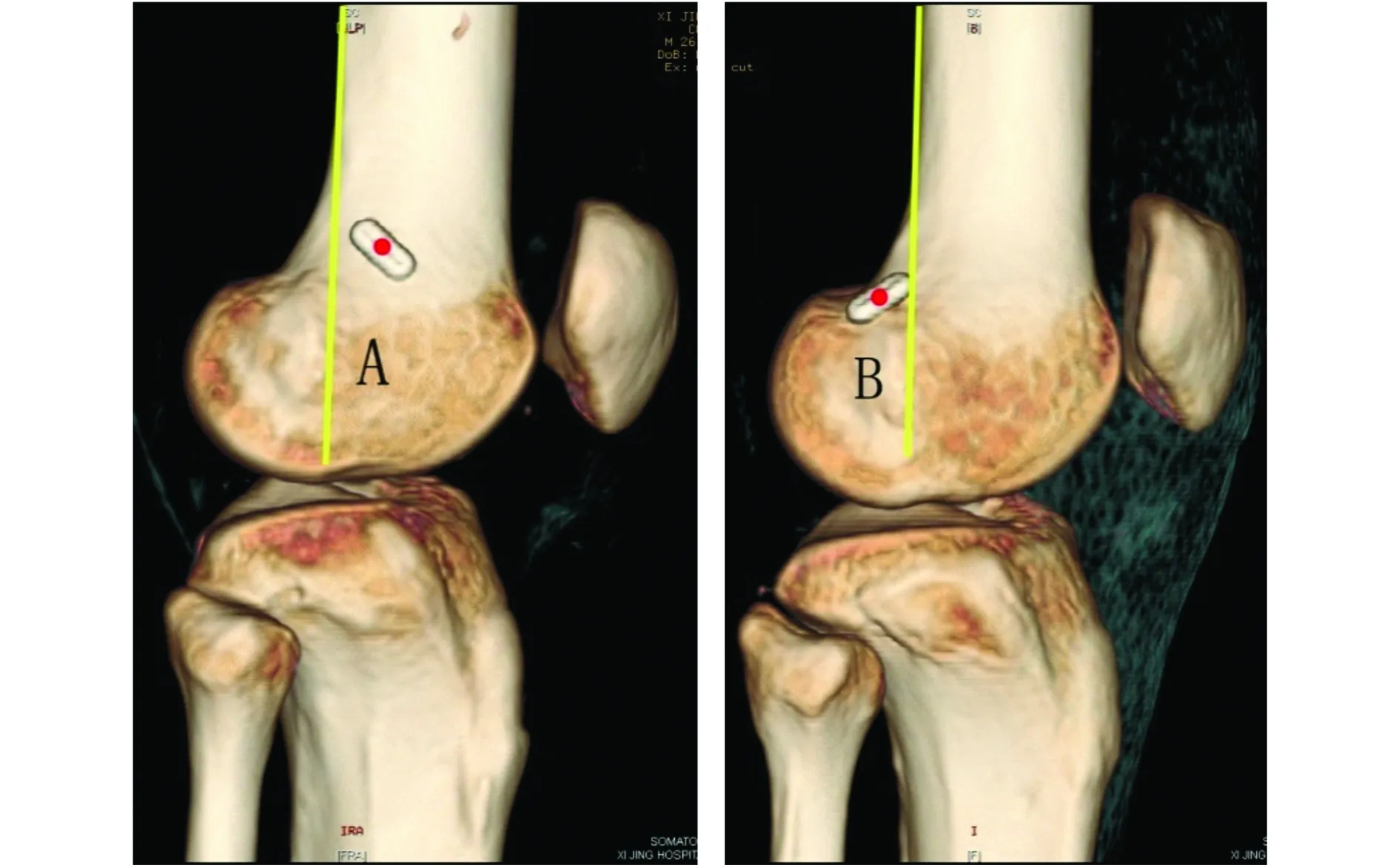
A.出口点位于股骨干后缘延长线前方 B.出口点位于延长线后方图2 股骨隧道出口位置的评估Figure 2 Evaluation of the femoral tunnel exit location
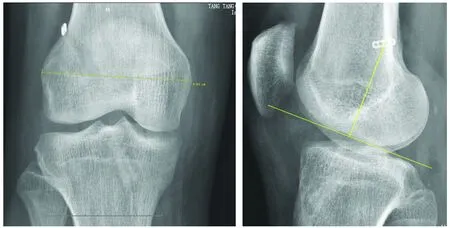
图3 股骨髁大小的测量和股骨隧道出口距股骨远端距离的测量Figure 3 Measurement of femoral condyle size and the distance from femoral tunnel exit to the distal femur
2 结果
本研究共纳入受试对象100例,80例患者于术中未行股骨髁间窝成形术,20例行股骨髁间窝成形术。术中测量股骨隧道长度为(37.04±4.57)mm(26-50 mm),术后测量股骨髁大小为(9.25±0.78)cm(7.51-10.59 cm),股骨隧道出口距股骨远端的距离为(4.68±0.54)cm(3.60-6.32 cm),使用Bernard四格表法测量股骨隧道定位,X轴为(27.19±4.69)%,Y轴为(32.20±7.59)%。所有受试对象术后Bernard四格表法评估股骨隧道定位均为解剖位置。术后3D-CT观察70例股骨隧道出口位于A位置,30例股骨隧道出口位于B位置。
将术中测量股骨隧道长度按照≤30 mm,31-35 mm,36-40 mm,≥41 mm分为4组,Bernard四格表法X轴定位在不同股骨隧道长度组间无显著差异(P=0.09,见表2)。Bernard四格表法Y轴定位在不同股骨隧道长度组间差异有统计学意义(P=0.03,见表3)。股骨髁大小在不同股骨隧道长度组间差异有统计学意义(P=0.00,见表4)。


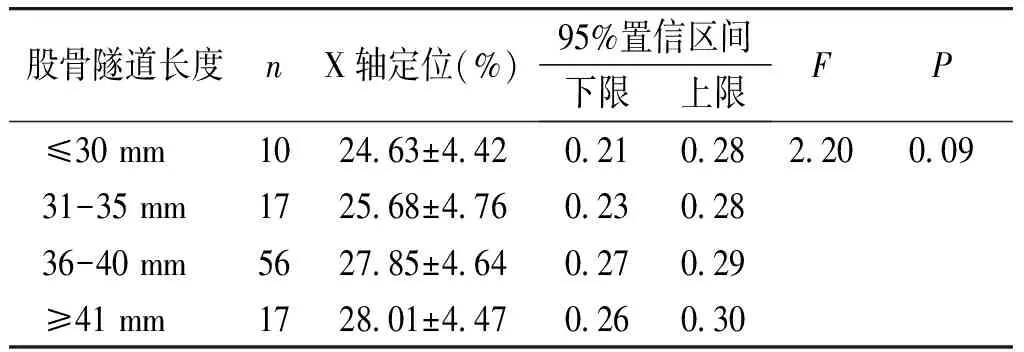
股骨隧道长度nX轴定位(%)95%置信区间下限上限FP ≤30mm1024 63±4 420 210 282 200 09 31-35mm1725 68±4 760 230 28 36-40mm5627 85±4 640 270 29 ≥41mm1728 01±4 470 260 30


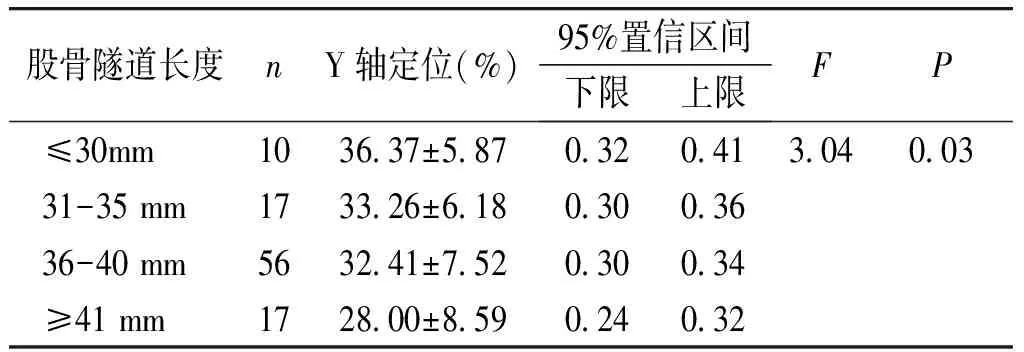
股骨隧道长度nY轴定位(%)95%置信区间下限上限FP ≤30mm1036 37±5 870 320 413 040 03 31-35mm1733 26±6 180 300 36 36-40mm5632 41±7 520 300 34 ≥41mm1728 00±8 590 240 32
股骨隧道长度与术中隧道的定位有明确相关性。其中,与Bernard四格表法X轴定位为正相关,其线性回归方程为y=30.15+25.34x,线性拟合相关系数R2=0.06,P=0.01(见图4);与Bernard四格表法Y轴定位为负相关,其线性回归方程为y=42.26-16.21x,线性拟合相关系数R2=0.07,P=0.00(见图5)。股骨隧道长度与股骨髁大小成正相关,其线性回归方程为y=13.60+2.54x,线性拟合相关系数R2=0.18,P=0.00(见图6)。



股骨隧道长度数量股骨髁长度(cm)95%置信区间下限上限FP ≤30mm108 61±0 937 949 285 980 00 31-35mm178 91±0 698 559 26 36-40mm569 34±0 729 159 54 ≥41mm179 66±0 639 349 99
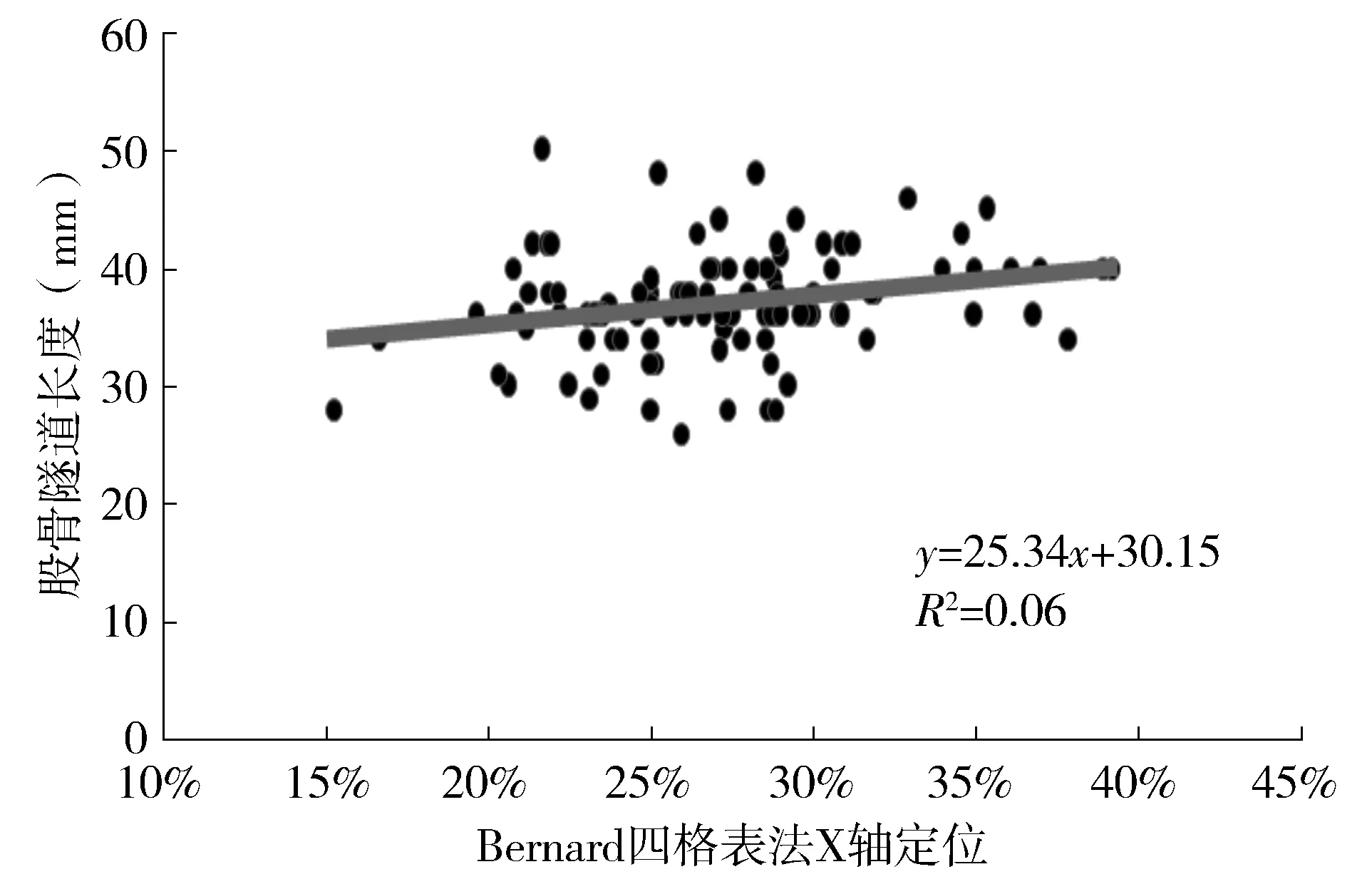
图4 Bernard四格表法X轴定位与股骨隧道长度的关系Figure 4 Relationship between X axis location and femoral tunnel length in Bernard four lattice table method
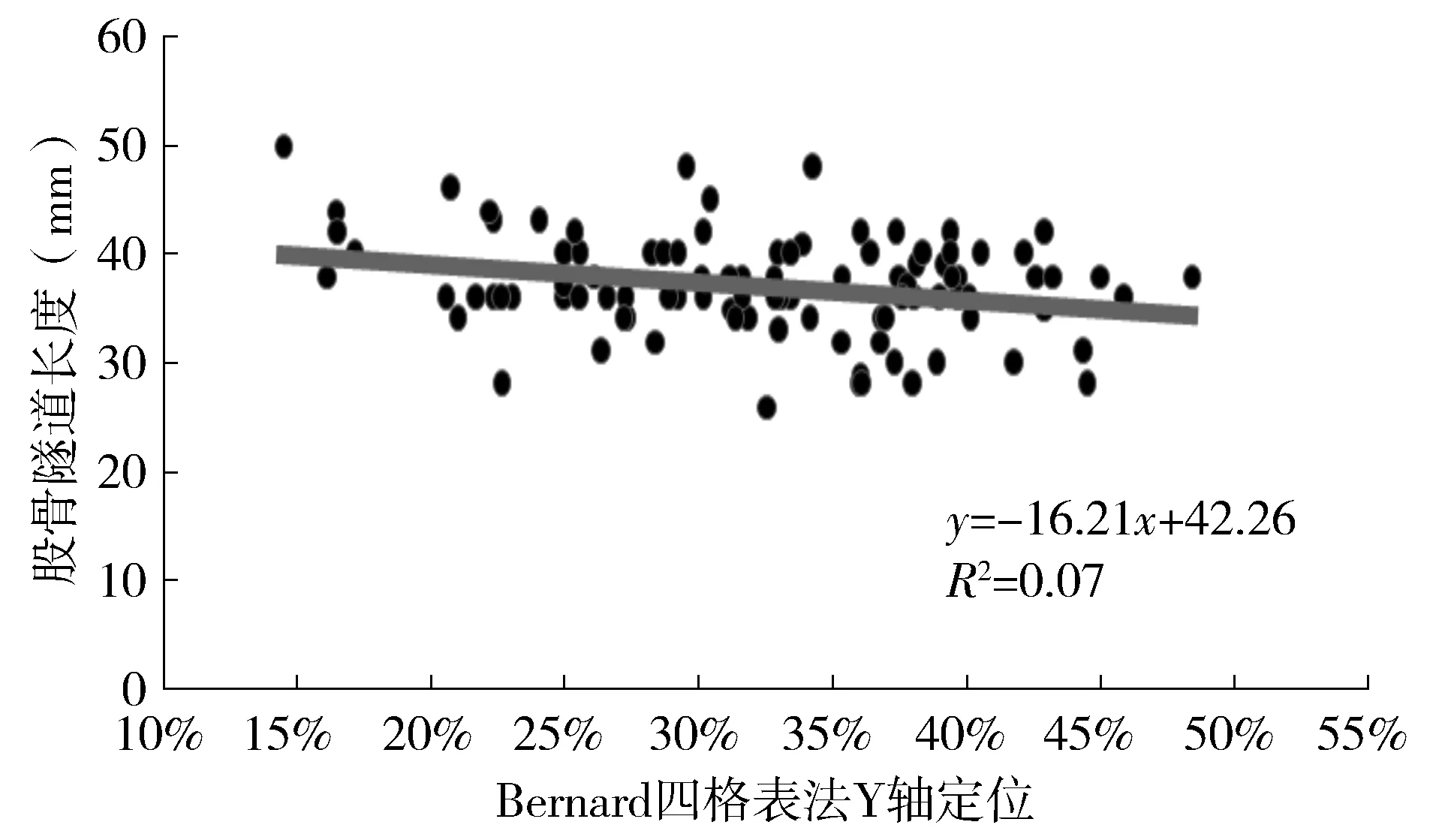
图5 Bernard四格表达Y轴定位与股骨隧道长度的关系Figure 5 Relationship between Y axis location and femoral tunnel length in Bernard four lattice table method
隧道出口位置A(在股骨干延长线之前)的隧道长度大于位置B(在延长线之后)的隧道长度,但二者股骨隧道长度差异无统计学意义(P=0.48,见表5);术中行髁间窝成形术的股骨隧道长度显著大于未行髁间窝成形术的隧道长度(P=0.04,见表6)。
股骨隧道出口距股骨远端的距离在不同股骨隧道长度组间差异有统计学意义(P=0.00,见表7);股骨隧道长度与股骨隧道出口距股骨远端的距离成正相关。其线性回归方程为y=25.35+2.51x,线性拟合相关系数R2=0.15,P=0.01(见图7)。
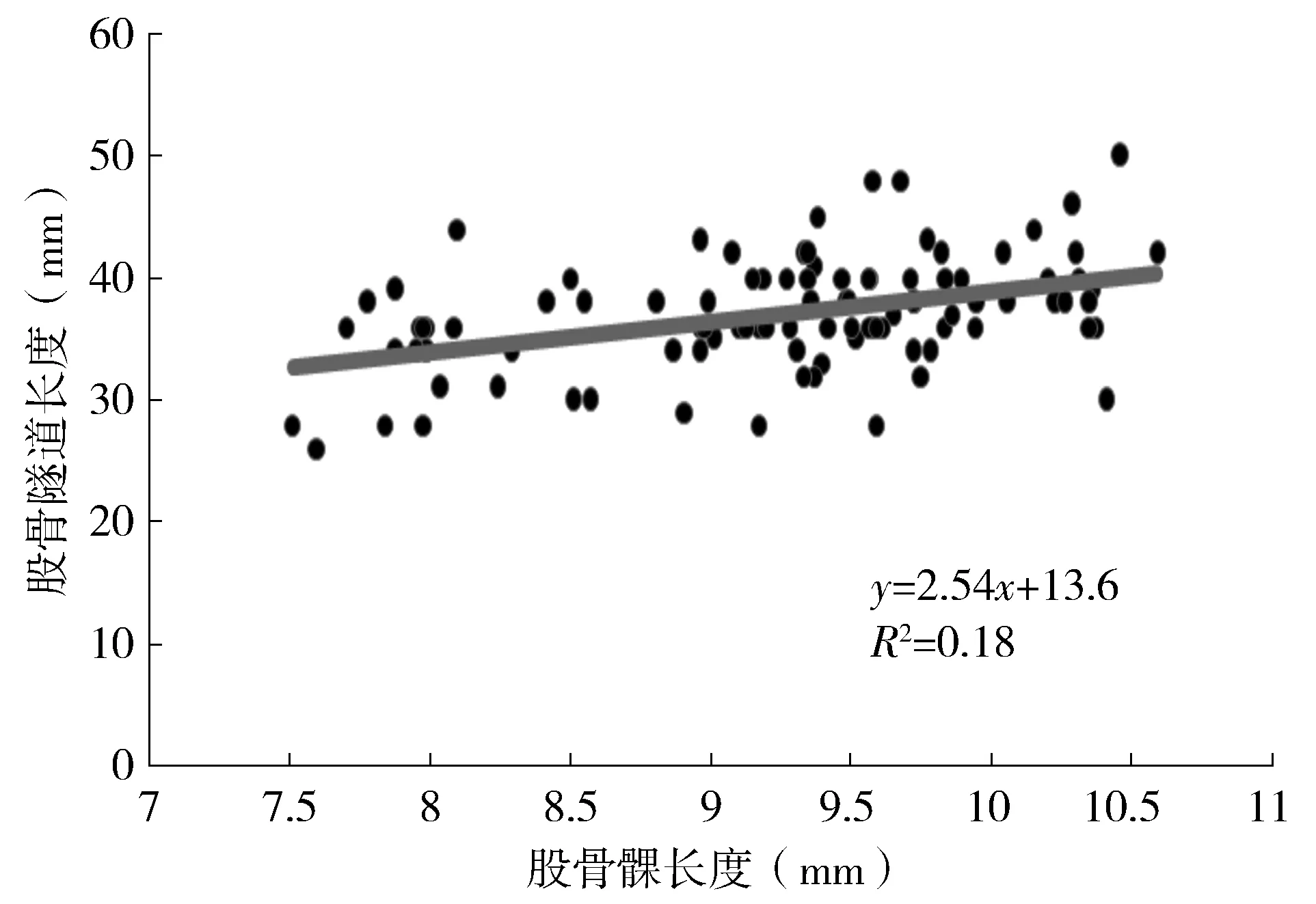
图6 股骨髁大小与股骨隧道长度的关系Figure 6 Relationship between femoral condyle size and femoral tunnel length



出口位置n股骨隧道长度(mm)95%置信区间下限上限PA7038 66±3 873 727 060 48B3033 27±3 843 717 07



分组n股骨隧道长度(mm)95%置信区间下限上限P未行髁间窝成型术8036 72±4 91-3 830 680 04行髁间窝成型术2038 30±2 58-3 170 02


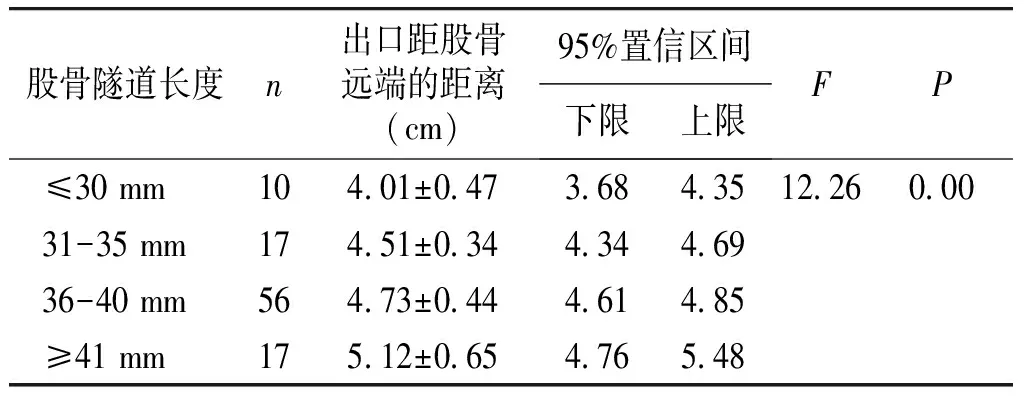
股骨隧道长度n出口距股骨远端的距离(cm)95%置信区间下限上限FP ≤30mm104 01±0 473 684 3512 260 00 31-35mm174 51±0 344 344 69 36-40mm564 73±0 444 614 85 ≥41mm175 12±0 654 765 48
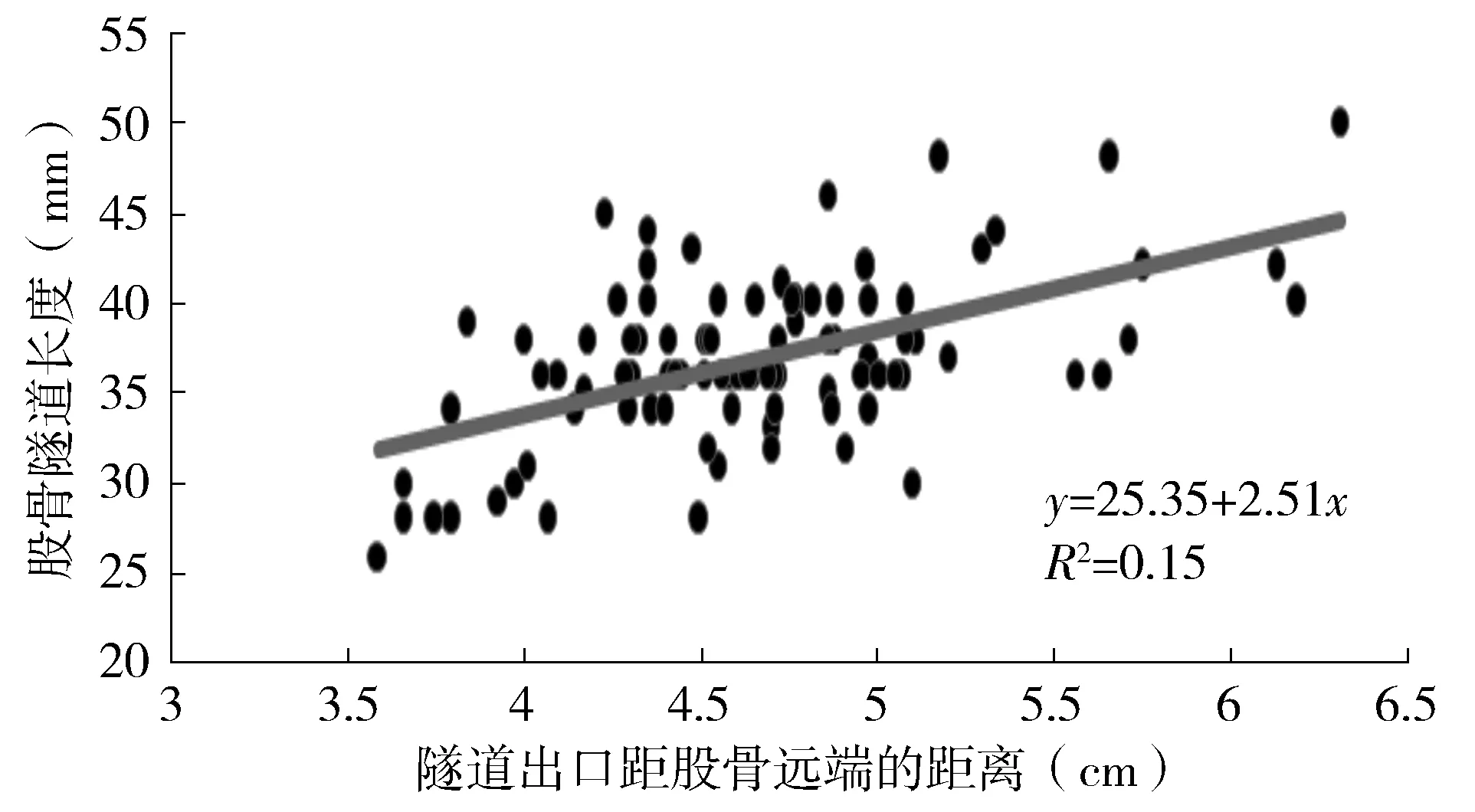
图7 隧道出口距股骨远端的距离与股骨隧道长度的关系Figure 7 Relationship between tunnel exit distance from the distal femur and femoral tunnel length
3 讨论
目前ACL制备股骨隧道的方法主要有经胫骨隧道的TT方法和经前内侧入路的AM方法。经AM方法制备的股骨隧道,其隧道入口更接近解剖位点[6,13-15],其临床预后更佳。然而,经AM方法制备的隧道也存在着隧道长度偏短甚至有可能打爆股骨髁后壁的风险[16-18]。我们术中采用AM技术,并测量股骨隧道长度平均为37.04 mm,其中低于30 mm的占1/10(10/100)。术后经3D-CT评估所有隧道位置均位于ACL自然生理足迹区。本研究发现,ACL重建术中股骨隧道Y轴定位点越高,则股骨隧道越长,定位点越低,则股骨隧道越短。该结论说明经AM技术制备股骨隧道时,在ACL自然足迹范围内,隧道定位越接近Blumensaat线,则可以获得满意的隧道长度。我们还发现股骨隧道长度与术中隧道的X轴定位为正相关,与Bernard四格表法Y轴定位为负相关,这说明术中股骨隧道定位越靠后、靠下则隧道长度越短。也就是说,如果术中定位偏后下侧,则获得的股骨隧道长度有可能不甚理想,甚至有打爆股骨后髁的风险。
理论上讲,股骨髁越大股骨隧道越长。有学者通过3D-CT发现,在使用AM技术制备股骨隧道时存在一定的斜率,可能影响到股骨隧道的长度[19]。研究认为,手术中矢状位钻取角度在50°-65°、轴位钻取角度在30°-45°时,95%的股骨隧道能长于35 mm,获得满意的长度。在我们的研究中,100例患者均由一名资深手术医师完成,术中屈膝120°徒手制备股骨隧道。我们发现,在股骨钻入角度相似的情况下,股骨髁越大,则股骨隧道越长,两者成线性相关。这提示我们,术前进行股骨髁大小的评估,可预测术中可能的股骨隧道长度,进而可在术中操作时,通过调整制备骨道的角度,获得满意的股骨隧道长度。对于股骨髁较大的患者,术中出现隧道过短,提示股骨后壁打爆的可能,需更换视野,反复检查及时调整。
本研究显示,尽管不同隧道出口位置下的股骨隧道长度有差别,出口位置越靠前,隧道长度越长,但这种差别无统计学意义。Gali等[20]通过尸体标本研究指出,在制备股骨隧道时,膝关节的屈曲角度决定了隧道出口的方向,在AM技术制备股骨隧道时,膝关节屈曲角度至少要达到110°才能获得安全的股骨隧道长度,避免股骨后髁被打爆的风险。这与多数学者的研究结果一致[21-24]。本研究发现,在膝关节屈曲115°至全屈曲状态的范围内,虽然低屈曲角度会导致隧道出口位置偏后,但这与全屈曲状态下隧道出口位置偏前的组在隧道长度上无显著差异。这可能提示,在关节屈曲度满意的情况下,制备股骨隧道均可获得合适的长度。本研究还发现,术中行髁间窝成形术与未行髁间窝成形术在股骨隧道长度上有显著差异,这种差异体现在行髁间窝成形后隧道长度相对更长。这是由于术中行髁间窝扩大成形多数是为了解除髁间窝前方入口的增生撞击[12],并不影响髁间窝后方韧带止点区域的骨质。相反,行髁间窝成形术后再制备股骨隧道时排除了增生骨质的干扰,视野更清晰,操作更方便,在钻取骨道时更好把握定位点及角度。
我们目前尚没有发现相关股骨隧道出口位置距股骨远端的距离与股骨隧道长度的关系的文献报道。在本研究中,我们发现股骨隧道长度与股骨隧道出口距股骨远端的距离成正相关。这一发现有可能用于指导股骨隧道出口的定位。因为传统TT方法制备股骨隧道的非解剖定位,目前对于股骨隧道的制备,有学者提出采用AM技术及OI(outside-in)技术[25-28]。相比较AM技术,OI技术制备股骨隧道具有防止后壁爆裂、避免过度屈膝关节致软骨损伤、手术操作视野开阔等优势,但OI技术的操作依赖切开外侧关节囊进行股骨隧道出口的定位。我们研究的发现可能为OI技术股骨隧道出口的定位及手术预后提供了一个新的研究方向。
本研究仍存在一下局限性:①本研究的病例均为ACL解剖重建,对于非解剖重建的病例,本研究的结论是否适用仍需进一步研究;②本研究的所有病例均采用AM技术制备股骨隧道,对于其他改进手段制备隧道的病例,本研究的结论是否适用仍需进一步研究;③屈曲角度会影响股骨隧道的长度,本研究未对屈曲角度进行精确的测量分组;④本研究为回顾性研究,尚需进行RCT进一步研究。
4 结论
ACL重建术中股骨隧道长度和入口定位、股骨髁大小、股骨隧道出口位置距股骨远端的距离相关,这可在术前进行隧道长度的预评估并作为术中定位的指导。
[1] Chen W, Xie B, Zu GH,etal. Oblique coronal view of the ACL double-bundle: Comparison of the Chinese visible human dataset and low-field MRI[J]. Exp Ther Med, 2013, 6(2):606-610.
[2] Frobell RB, Roos EM, Roos HP,etal. A randomized trial of treatment for acute anterior cruciate ligament tears[J].N Engl J Med, 2010, 363(4): 331-342.
[3] Kim HS, Seon JK, Jo AR.Current trends in anterior cruciate ligament reconstruction[J].Knee Surg Relat Res, 2013, 25(4):165-173.
[4] Markatos K, Kaseta MK, Lallos SN,etal. The anatomy of the ACL and its importance in ACL reconstruction [J]. Eur J Orthop Surg Traumatol, 2013, 23(7):747-752.
[5] 韩先伟,李光政,徐虎,等.关节镜下前交叉韧带股骨止点定位新方法的研究[J].中华创伤骨科杂志,2013,15(11):947-950.
[6] Alentorn-Geli E, Lajara F, Samitier G,etal. The transtibial versus the anteromedial portal technique in the arthroscopic bone-patellar tendon-bone anterior cruciate ligament reconstruction[J]. Knee Surg Sports Traumatol Arthrosc,2010,18(8):1013-1037.
[7] Chalmers PN, Mall NA, Cole BJ,etal. Anteromedial versus transtibial tunnel drilling in anterior cruciate ligament reconstructions: a systematic review[J].Arthroscopy,2013,29(7):1235-1242.
[8] George MS, Huston LJ, Spindler KP. Endoscopic versus rear-entry ACL reconstruction: a systematic review[J]. Clin Orthop Relat Res, 2007, 455(455):158-161.
[9] Riboh JC, Hasselblad V, Godin JA,etal. Transtibial versus independent drilling techniques for anterior cruciate ligament reconstruction: a systematic review, meta-analysis, and meta-regression[J]. Am J Sports Med, 2013, 41(11):2693-2702.
[10] Chang CB, Yoo JH, Chung BJ,etal. Oblique femoral tunnel placement can increase risks of short femoral tunnel and cross-pin protrusion in anterior cruciate ligament reconstruction[J]. Am J Sports Med, 2010, 38(6):1237-1245.
[11] Golish SR, Baumfeld JA, Schoderbek RJ,etal. The effect of femoral tunnel starting position on tunnel length in anterior cruci-ate ligament reconstruction: a cadaveric study[J]. Arthroscopy, 2007, 23(11):1187-1192.
[12] 张春礼,徐虎,王迎春,等.前十字韧带移植重建后移植物撞击新类型[J]中华骨科杂志,2015,35(4):380-386
[13] Abebe ES, Rd MC, Dziedzic TS,etal. Femoral tunnel placement during anterior cruciate ligament reconstruction: an in vivo imaging analysis comparing transtibial and 2-incision tibial tunnel-independent techniques[J]. 2009, 37(10):1904-1911.
[14] Tompkins M, Milewski MD, Brockmeier SF,etal. Anatomic femoral tunnel drilling in anterior cruciate ligament reconstruction: use of an accessory medial portal versus traditional transtibial drilling[J]. Am J Sports Med, 2012, 40(6):1313-1321.
[15] Bedi A, Musahl V, Steuber V,etal. Transtibial versus anteromedial portal reaming in anterior cruciate ligament reconstruction: an anatomic and biomechanical evaluation of surgical technique[J]. Arthroscopy, 2011, 27(3):380-390.
[16] Bowers AL, Bedi A, Lipman JD,etal. Comparison of anterior cruciate ligament tunnel position and graft obliquity with transtibial and anteromedial portal femoral tunnel reaming techniques using high-resolution magnetic resonance imaging[J]. Arthroscopy, 2011, 27(11):1511-1522.
[17] Lubowitz J H, Konicek J. Anterior cruciate ligament femoral tunnel length: cadaveric analysis comparing anteromedial portal versus outside-in technique[J].Arthroscopy,2010,26(10):1357-1362.
[18] Miller CD, Gerdeman AC, Hart JM,etal. A comparison of 2 drilling techniques on the femoral tunnel for anterior cruciate ligament reconstruction[J]. Arthroscopy, 2011, 27(3):372-379.
[19] Iyyampillai G, Raman ET, Rajan DV,etal. Determinants of femoral tunnel length in anterior cruciate ligament reconstruction: CT analysis of the influence of tunnel orientation on the length[J]. Knee Surg Relat Res, 2013, 25(4):207-214.
[20] Gali JC, Hc DSO, Ciancio BA,etal. Femoral tunnels’ length changes with knee flexion angle in anatomical anterior cruciate ligament reconstruction[J]. Revista Brasileira De Ortopedia, 2012, 47(2):246-250.
[21] Cha PS, Brucker PU, West RV,etal. Arthroscopic double-bundle anterior cruciate ligament reconstruction: an anatomic approach[J]. Arthroscopy, 2005, 21(10):1275.
[22] Basdekis G, Abisafi CP. Influence of knee flexion angle on femoral tunnel characteristics when drilled through the anteromedial portal during anterior cruciate ligament reconstruction[J]. Arthroscopy, 2008, 24(4):459-464.
[23] Siddharth R, Anubha S, Soumyaditya M,etal. Potential risk of cartilage damage in double bundle ACL reconstruction: impact of knee flexion angle and portal location on the femoral PL bundle tunnel[J].Arch Orthop Trauma Surg,2008,128(5):509-513.
[24] Bedi A, Altchek DW. The “footprint” anterior cruciate ligament technique: an anatomic approach to anterior cruciate ligament reconstruction[J]. Arthroscopy, 2009, 25(25):1128-1138.
[25] Chang MJ, Chang CB, Won HH,etal. Anteromedial portal versus outside-in technique for creating femoral tunnels in anatomic anterior cruciate ligament reconstructions[J]. Arthroscopy, 2013, 29(9):1533.
[26] Jin HA, Yong SL, Lee SH. Creation of an anatomic femoral tunnel with minimal damage to the remnant bundle in remnant-preserving anterior cruciate ligament reconstruction using an outside-in technique[J]. Arthrosc Tech, 2014, 3(1):e175-e179.
[27] Gelber PE, Erquicia J, Abat F,etal. Effectiveness of a footprint guide to establish an anatomic femoral tunnel in anterior cruciate ligament reconstruction: computed tomography evaluation in a cadaveric model[J]. Arthroscopy, 2011, 27(6):817-824.
[28] Kim K, Lee SH, Bae C,etal. Three-Dimensional reconstruction computed tomography evaluation of the tunnel location and angle in anatomic single-bundle anterior cruciate ligament reconstruction: acomparison of the anteromedial portal and outside-in techniques[J]. Knee Surg Relat Res, 2017, 29(1):11-18.
Influentialfactorsoffemoraltunnellengthinanteriorcruciateligamentreconstruction
WANG Yingchun, DING Ming, YU Lifeng, LIAO Binghui, ZHEN Zhilei, XU Hu, ZHANG Chunli*
(DepartmentofOrthopedicsSportsInjury,XijingHospital,FourthMilitaryMedicalUniversity,Xi’an710032,China;*Correspondingauthor,E-mail:zhangcl816@sohu.com)
ObjectiveTo explore the factors affecting the length of the femoral tunnel during anterior cruciate ligament(ACL) reconstruction.MethodsThis study was a retrospective study. One hundred patients with ACL rupture were evaluated by X-ray and dual energy CT scan after ACL reconstruction. The position of the femoral tunnel and the location of the femoral tunnel outlet were evaluat-ed, and the length of the femoral condyle was measured. The influence of the above factors on the length of femoral tunnel was analyzed.ResultsThere was no significant difference in X axis location by Bernard four lattice table method between different femoral tunnel length groups(P=0.09),but there was a significant difference in Y axis location by Bernard four lattice table method between the different length groups(P=0.03). There was a significant difference in the length of femoral condyle between different length groups(P=0.00). The length of the femoral tunnel was positively correlated with the X axis evaluated by Bernard four grid method, and the linear regression equation wasy=30.15+25.34x(R2=0.06,P=0.01), but it was negatively correlated with Y axis positioning evaluated by Bernard four grid method, and the linear regression equation wasy=42.26-16.21x(R2=0.07,P=0.00). The length of the femoral tunnel was positively correlated with the length of the femoral condyle, and the linear regression equation wasy=13.60+2.54x(R2=0.18,P=0.00). There was no significant difference in the length of femoral tunnel between different tunnel outlet locations(P=0.48). The distance of femoral tunnel exit to the distal femur had a significant difference among different femoral tunnel length groups(P=0.00), and there was a positive correlation between them, and the linear regression equation wasy=25.35+2.51x(R2=0.153,P=0.01). There was a significant difference in the length of femoral tunnel between patients undergoing intercondylar fossa plasty or not(P=0.04).ConclusionThe influential factors of femoral tunnel length in anterior cruciate ligament reconstruction are the location of femoral tunnel, the length of femoral condyle and the distance of femoral tunnel exit to distal femur, which can be used for preoperatively evaluating the tunnel length and guiding intraoperative positioning.
anterior cruciate ligament; femoral tunnel; arthroscopy
王迎春,男,1982-01生,硕士,主治医师,E-mail:yingchun20002009@163.com
2017-09-06
R686
A
1007-6611(2017)12-1295-07
10.13753/j.issn.1007-6611.2017.12.021
